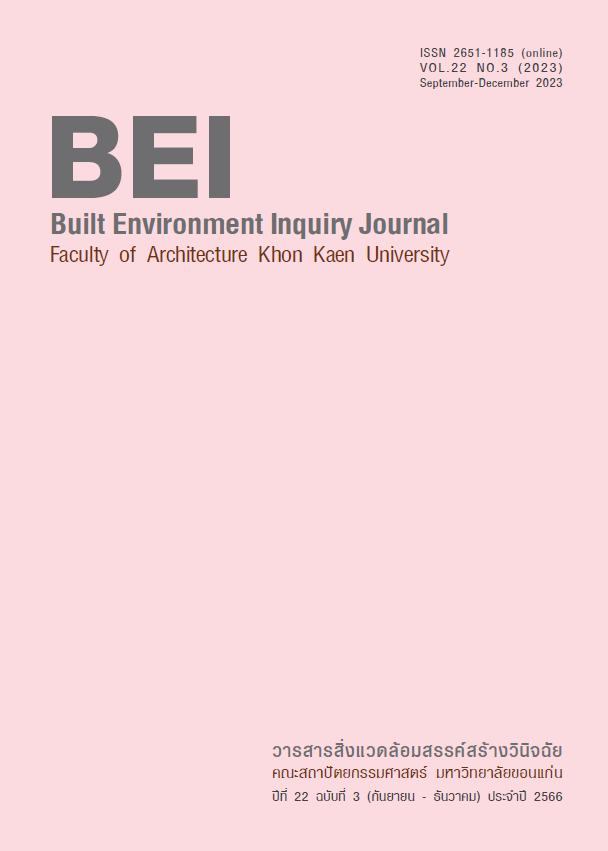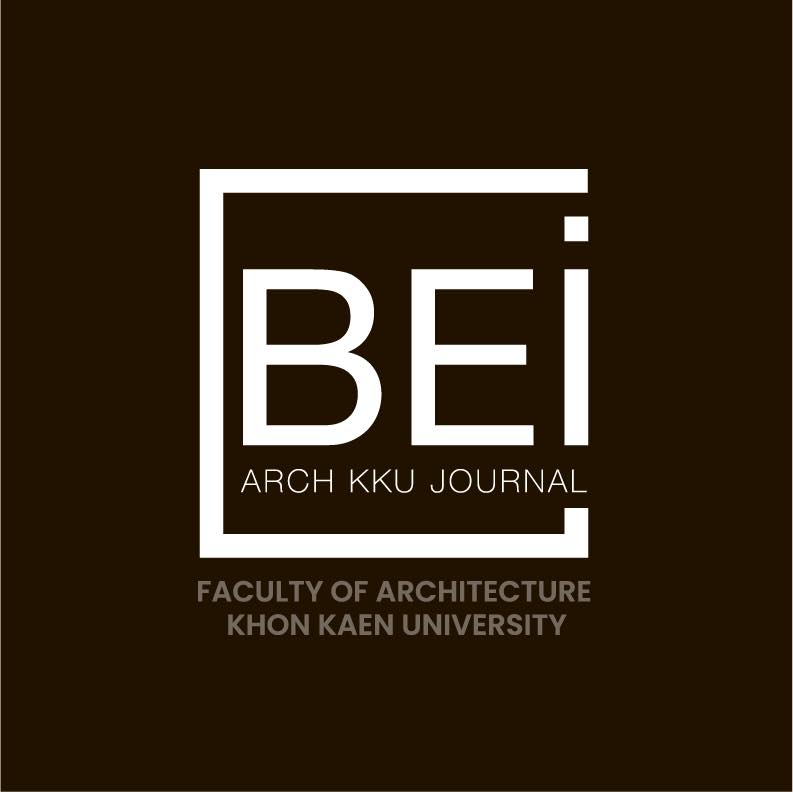เกณฑ์การประเมินอาคารในปัจจุบันและความยั่งยืน
DOI:
https://doi.org/10.14456/bei.2023.25คำสำคัญ:
เกณฑ์การประเมินอาคาร, เกณฑ์การประเมินความยั่งยืนทางพลังงานและสิ่งแวดล้อมไทย, ความยั่งยืน, การพัฒนาที่ยั่งยืนบทคัดย่อ
งานวิจัยนี้มีวัตถุประสงค์เพื่อทบทวนเกณฑ์การประเมินอาคารในปัจจุบันซึ่งนำไปสู่ความเข้าใจกรอบแนวคิด
และทิศทางรวมถึงปัญหาและข้อจำกัดของเกณฑ์จากแนวคิดเรื่องความยั่งยืน จากการสำรวจลักษณะของเกณฑ์ที่มีใช้
ในปัจจุบัน 16 เกณฑ์ ศึกษาเปรียบเทียบเกณฑ์ดังกล่าวกับตัวชี้วัดความยั่งยืนของ Circles of Sustainability ได้แก่
Ecology, Economics, Politics และ Culture และสำรวจความคิดเห็นของผู้เชี่ยวชาญที่มีต่อเกณฑ์การประเมิน
อาคารในปัจจุบัน
ผลการศึกษาพบว่าเกณฑ์ในปัจจุบันมีจุดมุ่งหมายเพื่อกระตุ้นให้อุตสาหกรรมการออกแบบ การก่อสร้างเกิด
การแข่งขัน และสร้างแรงจูงใจให้สร้างสรรค์ผลงานที่ตอบรับกับหลักการพัฒนาที่ยั่งยืน จากการศึกษาเปรียบเทียบ
โครงสร้างของเกณฑ์และตัวชี้วัดของความยั่งยืนของ Circles of Sustainability ที่สำรวจพบว่าเกณฑ์ส่วนใหญ่ให้ความ
สำคัญต่อมิติทางสิ่งแวดล้อม (Ecology) มากที่สุด ตามมาด้วยมิติทางเศรษฐกิจ (Economics) ส่วนมิติทางรัฐศาสตร์
(Politics) และวัฒนธรรม (Culture) ได้รับความสำคัญน้อยที่สุด และมีเพียง 6 จาก 16 เกณฑ์ที่ให้ความสำคัญต่อเสา
หลักของความยั่งยืนทั้งสี่มิติ ได้แก่ BREEAM CASBEE GB-Tool VERDE Estidama และ DGBN นอกจากนี้ยังพบว่า
มีเพียงบางเกณ์เท่านั้นที่คำนึงถึงกระบวนการออกแบบก่อสร้างตลอดทั้งวงจรชีวิตของอาคาร โดยเกณฑ์ส่วนใหญ่มักให้ความสำคัญต่อกระบวนการออกแบบและก่อสร้างเป็นหลักแต่ขาดการให้ความสำคัญในขั้นตอนของการใช้งานอาคาร
เป็นต้น
ผลการสำรวจความคิดเห็นของผู้เชี่ยวชาญ 25 คน ต่อเกณฑ์ในปัจจุบันพบว่าเหตุผลในการเข้าร่วมเกณฑ์
เพื่อเป็นการเพิ่มระดับความน่าเชื่อถือและภาพลักษณ์ขององค์กร เพื่อให้เป็นไปตามกฎหมายข้อบังคับ หรือเพิ่มศักยภาพ
ในการแข่งขันทางการค้า เป็นหลัก โดยมีความเห็นว่าเกณฑ์ในปัจจุบัน “ไม่ได้ออกแบบจากโครงสร้างพื้นฐานของพื้นที่
และสภาพทางภูมิศาสตร์” “ไม่ได้มีส่วนร่วมของชุมชนและท้องถิ่น” ”ต้องใช้ผู้เชี่ยวชาญเท่านั้น” และ “ต้นทุนในการ
เข้าร่วมสูง” และเห็นด้วยกับประเด็นที่ว่าลักษณะของเกณฑ์ที่พึงมีควรคำนึงถึง “สิ่งแวดล้อม” “การพัฒนาชุมชนและท้องถิ่น” และ “ความหลากหลายของพื้นที่” โดยควรจะ “เข้าถึงได้ง่าย” และ “มีทางเลือกในการออกแบบและ
สร้างสรรค์ผลงาน” ผลการศึกษาดังกล่าวแสดงให้เห็นช่องว่างเกี่ยวกับโครงสร้างและลักษณะที่พึงประสงค์ของเกณฑ์
ประเมินอาคารที่มีใช้ในในปัจจุบันซึ่งเป็นข้อมูลสำคัญในการนำไปสู่การพัฒนาเกณฑ์ทางเลือกต่อไป
เอกสารอ้างอิง
จักรกฤษณ์ เหลืองเจริญรัตน์, และสิงห์ อินทรชูโต. (2556). เกณฑ์ประเมินอาคารที่ยั่งยืน: ความเหมือน ความต่าง และค่าความสำคัญที่ให้ต่อสิ่งแวดล้อม ทรัพยากร และพลังงาน. คณะสถาปัตยกรรมศาสตร์ มหาวิทยาลัยเกษตรศาสตร์.
พันธุดา พุฒิไพโรจน์. (2557). การออกแบบและก่อสร้างอาคารเขียว ตามเกณฑ์มาตรฐาน LEED. สำนักงานนโยบายและแผนทรัพยากรธรรมชาติและสิ่งแวดล้อม.
วิจิตรบุษบา มารมย์. (2560). การประเมินองค์ความรู้ด้านเมืองยั่งยืนในประเทศไทย. ชุดโครงการเมืองยั่งยืน สำนัก ประสานงาน ชุดโครงการเมืองยั่งยืน ศูนย์วิจัยและฝึกอบรมนิเวศวิทยาอุตสาหกรรม คณะสิ่งแวดล้อม และทรัพยากรศาสตร์ มหาวิทยาลัยมหิดล.
สถาบันอาคารเขียวไทย. (2555). คู่มือสำหรับเกณฑ์การประเมินความยั่งยืนทางพลังงานทางสิ่งแวดล้อมไทย. กรุงเทพมหานคร: สถาบันอาคารเขียวไทย.
สุลาวัลย์ ทันใจชน, และณฐพงศ์ พ่วงภิญโญ. (2022). เกณฑ์การประเมินความยั่งยืนของอาคาร: แนวคิดและการใช้งาน. วารสารสถาปัตยกรรม การออกแบบและการก่อสร้าง, คณะสถาปัตยกรรมศาสตร์ ผังเมืองและนฤมิตศิลป์ มหาวิทยาลัยมหาสารคาม, 4 (3), 119-140.
Abu Dhabi Urban Planning Council. (2016), The Pearl Rating System for Estidama Emirate of Abu Dhabi. Pearl Building Rating System: Design & Construction, Version 1.0.
Ali, H., & Alnusairat, S. (2009). Developing a green building assessment tool for developing countries – Case of Jordan, Building and Environment, 44 (5), 1053-1064.
DOI: 10.1016/2008.07.015
Alwaer, H., & Croome. C, D.J. (2010). Key performance indicators (KPIs) and priority setting in using the multi-attribute approach for assessing sustainable intelligent buildings. Building and Environment, 45 (4), 799-807.
DOI: 10.1016/2009.08.019
Alyamia, S. H., & Rezgui, Y. (2012). Sustainable building assessment tool development approach, Sustainable Cities and Society, 5, 52-62.
DOI: 10.1016/2012.05.004
Assefa, S., Lee, H. Y., & Shiue, F. J. (2022). A building sustainability assessment system (BSAS) for least developed countries: A case of Ethiopia, Sustainable Cities and Society, 87
DOI: 10.1016/2022.104238
Astara, O. H. (2014). Culture as The Fourth Pillar of Sustainable Development. Journal Sustainable Development. Culture. Traditions.
Barnard, A., & Spencer, J. (1996). Encyclopedia of Social and Cultural Anthropology. London: Routledge.
BEAM Society Limited. (2019). BEAM Plus New Buildings, Version 2.0.
BRE Global Ltd. (2016). BREEAM International New Construction. Technical Manual. Document reference: SD233, (2).
Building and Construction Authority. (2012). The BCA Green Mark Certification Standard for New Buildings, Version 4.1.
CIB General Secretariat. (1999). Agenda 21 on sustainable construction. [Online]. Retrieved January 16, 2018, from www.cibworld.nl
Cole, R. J., Howard, N., Ikaga, T., & Nibel, S. Building Environmental Assessment Tools: Current and Future Roles. [Online]. from http://www.sb05.com/ academic/4&5_IssuePaper.pdf
Cole, R. J., & Larsson, N. (2002). GBTool User Manual, Green Building Challenge.
Cuadrado, J., Zubizarreta, M., Rojí, E., García, H., & Larrauri, M. (2015). Sustainability-Related Decision Making in Industrial Buildings: An AHP Analysis. Mathematical Problems in Engineering
DOI: 10.1155/2015/157129
Darr, C. (2005). A hitchhiker's guide to reliability. [Online]. Retrieved January 18, 2018, from
www.nzcer.org.nz/nzcerpress/set/articles/hitchhikers-guide-reliability
https://doi.org/10.18296/set.0623
DGNB System. (2020). New buildings criteria set. Evaluation and structure of the DGNB System.
France GBC. (2015). The positioning of HQE certification relative to BREEAM and LEED. International environmental certifications: Feedback and outlook.
Global Cities Research Institute, (2012), Annual Review Global Cities. [Online]. Retrieved January 20, 2018, from http://global-cities.info/wp-content/uploads/2013/06/GCRI-2012-Annual-Review-REV-Web-Version.pdf
Green Building Council Espana (GBCe). (2017). VERDE Certification. [Online]. Retrieved January 18, 2018, from www.gbce.es
Green Building Council Indonesia. (2014). GREENSHIP New Building, Version 1.1.
Green Building Council of Australia. (2020). Introducing Green Star. [Online]. Retrieved from www.gbca.org.au.
Hawkes, J. (2001). The Fourth Pillar of Sustainability, Culture’s essential role in public planning.
Institute for Building Environment and Energy Conservation, (IBEC) and Japan Sustainable Building Consortium (JSBC). (2014). CASBEE for Buildings (New Construction).
International Council on Monuments and Sites (ICOMOS). (1999). International Cultural Tourism Charter. Managing Tourism at Places of Heritage Significance.
Jary, D., & J. (1991) The Harper Collins Dictionary of Sociology, New York: Harper Collins.
Kalagasidis, A. S., & Rode, C. (2015). Probabilistic Assessment. Annex 55 Reliability of Energy Efficient Building Retrofitting- Probability Assessment of Performance and Cost (RAP-RETRO).
KIDD C. V., (1992). The evolution of sustainability. Journal of Agricultural and Environmental Ethics, 5, 1-26.
Lazar, N., & K, Chithra. (2020). A comprehensive literature review on development of Building Sustainability Assessment Systems. Journal of Building Engineering, 32
DOI: 10.1016/2020.101450
Lee A., & O’Neil. (2004). The concept of sustainability. Accessed 10 April 2016. [Online]. Retrieved From http://dspace.nwu.ac.za/bitstream/handle/10394/2252/Schutte_IC_Chapter2_Sustainability.pdf?sequence=10
Marhani, M.A., & Muksain, M.A.S. (2018). GBI assessment checklist: Level of awareness of the contractors in the Malaysian construction industry. IOP Conference Series: Earth and Environmental Science.
Naghizadeh, M. (2000). The relationship (tradition of Iranian architecture) between identity and modernism and modernity. Journal of fine arts, 7.
Petrini, F., Manenti, S., Gkoumas, K., & Bontempi, F. (2010). Structural design and analysis of offshore wind turbines from a system point of view. Wind Engineering, 34, 85–108.
DOI: 10.1260/0309-524X.34.1.85
Saaty., & Sodenkamp. (2010). The analytic hierarchy and analytic network measurement processes: The measurement of intangibles. In Zopounidis, C., & Pardalos, P. M. (Eds.) Handbook of Multicriteria Analysis. Germany: Springer Berlin Heidelberg, pp. 91-166
Sadeghi, M., Naghedi, R., Behzadian, K., Shamshirgaran, A., Tabrizi, M. R., & Maknoon, R. (2022). Customisation of green buildings assessment tools based on climatic zoning and experts judgement using K-means clustering and fuzzy AHP. Building and Environment, 223
DOI: 10.1016/2022.109473
The Sustainable Tourism Summit: Rhode Island, (2006). [Online]. Retrieved from
http://www.sustainabletourismlab .com/summitagenda.pdf
Tylor, E. B. (1958). Primitive Culture: The origins of culture, New York: Harper.
United Cities and Local Governments (UCLG). (2015). Committee on Culture, Agenda 21 for Culture. Culture 21: Actions: Commitments on the role of culture in sustainable cities.
United Cities and Local Governments (UCLG). (2010). Culture: Fourth Pillar of Sustainable Development.
United Nations Settlements Programme (UN-Habitat). (2017). Building Sustainability Assessment and Benchmarking – An Introduction. [Online]. Retrieved from www.unhabitat.org.
United Nations Educational Scientific and Cultural Organization (UNESCO). (2016). Global Report on Culture for Sustainable Urban Development, Paris (France).
United Nations Educational Scientific and Cultural Organization (UNESCO). (2013). Introducing Cultural Heritage into Sustainable Development Agenda. [Online]. Retrieved from
www.unesco.org/new/fileadmin/.../HQ/.../CulturalHeritageFinalENG.pdf
United Nations Educational Scientific and Cultural Organization (UNESCO). (2005). the Protection and Promotion of the Diversity of Cultural Expressions. Scientific and Cultural Organization.
United Nations Educational Scientific and Cultural Organization (UNESCO). (2001). Universal Declaration
on Cultural Diversity.
United Nations Educational Scientific and Cultural Organization (UNESCO). (2002). Universal Declaration
on Cultural Diversity. Division of Cultural Policies and Intercultural Dialogue.
U.S. Green Building Council. (2019). LEED v4 for Building Design and Construction. [Online]. Retrieved December 20, 2017, from www.usgbc.org/leed.
U.S. National Environmental Policy Act (NEPA). (1969). The goal of sustainability. Sustainability Primer.
World Commission on Environment and Development (WCED). (1987). Our common future (the (Brundtland Report), Oxford University.
Zhang, Y. (2015). Research on Green Building Assessment System in China Inspired by LEED V4 and Other Foreign Assessment System. The Degree of Master of Science in Architectural Studies. University of Florida
Zuniga, L. (1997) Studying Culture and History in Exotic Places and at Home, Advances in Environment, Behavior and Design, 4, 41-70
DOI: 10.1007/978-1-4757-4425-5_2
ดาวน์โหลด
เผยแพร่แล้ว
รูปแบบการอ้างอิง
ฉบับ
ประเภทบทความ
สัญญาอนุญาต
ลิขสิทธิ์ (c) 2023 สิ่งแวดล้อมสรรค์สร้างวินิจฉัย

อนุญาตภายใต้เงื่อนไข Creative Commons Attribution-NonCommercial-NoDerivatives 4.0 International License.
ทัศนะและข้อคิดเห็นของบทความที่ปรากฏในวารสารฉบับนี้เป็นของผู้เขียนแต่ละท่าน ไม่ถือว่าเป็นทัศนะและความรับผิดชอบของกองบรรณาธิการ




